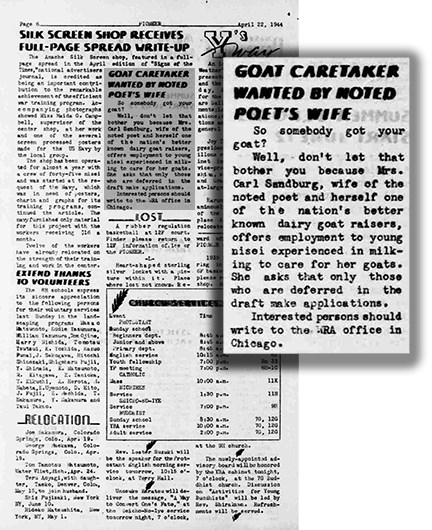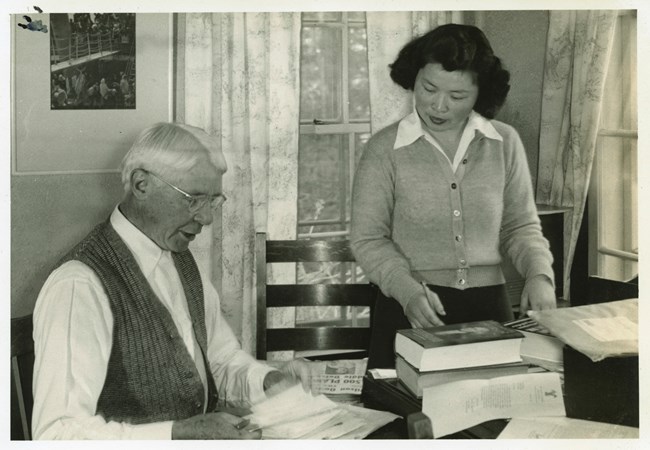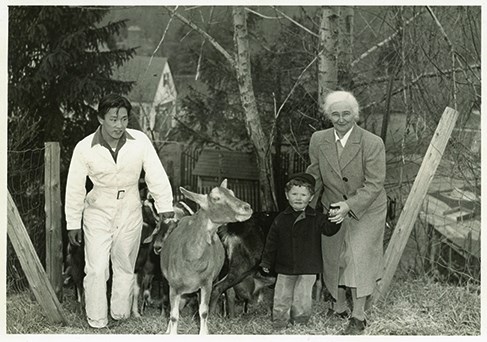Last updated: February 18, 2022
Article
Japanese American Incarcerees Sponsored by Carl Sandburg
Japanese American Incarceration
On February 19, 1942, President Roosevelt issued Executive Order 9066, which called for the involntary removal of Japanese American civilians, many American citizens, from the west coast to government sanctioned confinement centers. Around 120,000 people were forced to leave their homes and give up their livelihoods and property, and in some cases were even separated from their families. In order to get permission to leave these confinement centers, Japanese Americans needed to secure an outside sponsor, provide proof of employment or education, and complete FBI background checks to prove their loyalty to the United States.1
The War Relocation Authority (WRA) was the federal agency created to care for the Japanese Americans forcibly removed from the west coast. The WRA built and operated the incarceration sites Japanese Americans were involuntarily confined in.2 The WRA’s mission eventually shifted from constructing and managing confinement centers to creating regional resettlement offices to assist those incarcerated in leaving the sites and assimilating into white middle-class environments. While restrictions on returning to the west coast continued, incarcerated individuals were encouraged to resettle in midwestern communities such as Chicago, where the first regional WRA office was opened.3
Through the War Relocation Authority office in Chicago, Lilian Sandburg advertised positions for a secretary and a farm hand. At the time, Carl, Lilian, Margaret, and Janet Sandburg were living roughly 60 miles southeast of Chicago in a four story house at the edge of Lake Michigan.

Library of Congress (loc.gov)
In a column for the Chicago Daily Times, Carl Sandburg voiced his support for Nisei, American born citizen of Japanese ancestry.
“The nisei […] American born Japanese whose tongues are more facile in the American than in the Japanese language, who have been pressed mainly in American culture molds, whose thought control has been predominantly American, they prize the battle wounds taken by nisei in Italian fighting. They say ‘We have sunk 25 Japanese ships in two days.’ They say, ‘What’s buzzin’ cousin?’ or ‘What’s knitten’, kitten?’ and they can make like any native born telling what mairzy doates is and how to cook it.”
“There may be treacherous Japanese waiting under cover, but it may count in favor of the nisei that so far there seem to be no cases of treason or espionage of sabotage.”4 (see article in photo gallery below)

John Steichen Images
Sunao Imoto
Black and White photo of Sunao Imoto standing beside Carl Sandburg as they examine papers together at a desk by a window in the Sandburg’s home in Harbert, Michigan.
Sunao Imoto was a California resident and UCLA graduate who was incarcerated at to the Poston War Relocation Center in Arizona after Roosevelt’s executive order. During her time there, Imoto worked as a junior core teacher for Block 59 of the Poston site. When searching for jobs as a way to leave Poston, she found the Sandburg’s secretarial job advertisement. In an article from the Poston Senior High School paper, Imoto stated: “It seems there are plenty of jobs in Chicago. There seems to be some discrimination against Japanese, although there are some fellows working in defense jobs at $1.25 an hour – experienced of course. Plenty of steno-clerk jobs for girls also, but you have to be able to sell yourself as a good American.”
In addition to hiring Imoto as their secretary, the Sandburgs acted as her sponsor in order to leave Poston. In response to the Sandburgs’ support of Japanese Americans, she added; “It’s encouraging to come across that sentiment out here.”5
At the time of Imoto’s employment, Lilian Sandburg served as the secretary for the Dairy Goat Association. Sunao assisted with typing for the association and occasionally worked for Carl Sandburg also.
In an interview from 2021, Adeline Thoman, the Sandburgs’ housekeeper in 1944, remembered her time working with Sunao Imoto fondly. In the evenings, when the workday was done, Sunao taught her to play bridge.

John Steichen Images
Kaye Miyamoto
Kaye Miyamoto, originally from Elk Grove California, was incarcerated at Jerom War Relocation Center in Arkansas after Roosevelt’s Executive Order. In 1944 he was hired as a farm hand by the Sandburgs and allowed to leave Jerome to live at their home in Michigan. Miyamoto was the third of his siblings to leave Jerome. His parents, along with one brother and sister, stayed at the site.
He described working with the Sandburgs as being treated like family. In an interview from 2021, Adeline Thoman, the Sandburgs’ former housekeeper, described Kaye as a quiet man who was “a perfect gentlemen.” The three employees lived together with the Sandburgs in their large Lake Michigan home.
In an article from the Denson Tribune, Kaye Miyamoto said; “I’m accepted as one of the family. I live in their home, I share the family table, and in the evenings I sit in the family circle and listen to Mr. Sandburg read from his literary writings.” (see article in photo gallery below)
“One of the best things about the Sandburgs is their friendliness. […] When I arrived Mrs. Sandburg said: ‘Everything here is yours. As long as you are here, you’re one of the family.’ That’s what I call democracy.”
While Miyamoto had no former farm experience, he helped to feed the goats and keep the barn in order. At the time, there were more than 100 Toggenburg and Nubian goats at the Sandburg farm.
He stated at the time: “I’m glad that I have relocated. I'm glad I am with the Sandburgs. They are a real American family.”6
Eventually, Kaye Miyamoto and Sunao Imoto left the Sandburg family and both relocated to Chicago. Adeline, Kaye, and Sunao kept in touch throughout the years and occasionally visited each other in the city. It is unknown whether the Sandburgs kept in touch with their former employees.
Listen to Adeline Thoman’s recollections of Kaye Miyamoto and Sunao Imoto below:
-
Adeline Thoman Interview (excerpt)
Listen to Adeline Thoman’s recollections of Kaye Miyamoto and Sunao Imoto, two Japanese Internees she worked with at the home of Carl and Lilian Sandburg.
- Credit / Author:
- NPS Recording
- Date created:
- 05/04/2021
Footnotes:
1 “Resettlement.” Resettlement | Densho Encyclopedia, October 8, 2020. https://encyclopedia.densho.org/Resettlement/.
2 “War Relocation Authority.” War Relocation Authority | Densho Encyclopedia, May 6, 2015. https://encyclopedia.densho.org/War_Relocation_Authority/.
3 “Resettlement in Chicago.” Resettlement in Chicago | Densho Encyclopedia, October 8, 2020. https://encyclopedia.densho.org/Resettlement_in_Chicago/.
4 “Carl Sandburg says Most Nisei are Loyal to U.S.,” Topaz Times, March 15, 1944, p. 4. Image 4 of Topaz times (Topaz, Utah), March 15, 1944 | Library of Congress (loc.gov) (accessed March 16 2021)
5 “Imoto Working for Sandburg,” Kampus Krier, May 7, 1943, p. 1. "Kampus Krier, "Senior High newspaper, Vol. I, nos. 1-4, 6 [see also: NARA Reel 28, Folder 43] (berkeley.edu) (accessed March 16 2021)
6 “Working for Sandburg's,” Denson Tribune, March 14, 1944, p. 5. Image 5 of Denson tribune (Denson, Ark.), March 14, 1944 | Library of Congress (loc.gov) (accessed March 16 2021)
Resources:
Learn more about the terminology used to communicate the history of incarceration during WWII at: Terminology and the Mass Incarceration of Japanese Americans during World War II (U.S. National Park Service) (nps.gov).
